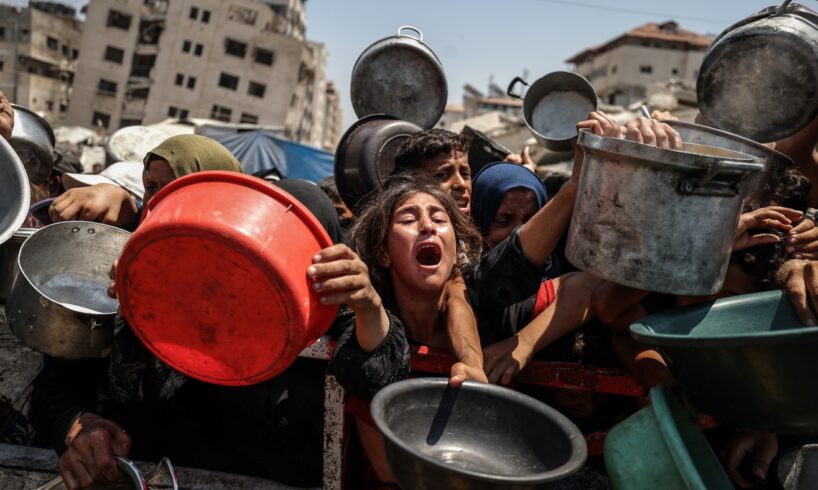
A charity distributes meals to Palestinians facing food shortages amid ongoing Israeli attacks and severe restrictions in Gaza City, Gaza on July 28, 2025.
Ali Jadallah/Andalou/via getty images
hide caption
toggle caption
Ali Jadallah/Andalou/via getty images
A United Nations-affiliated organization that tracks food security worldwide has issued a dire alert confirming that a worst-case famine scenario is unfolding across the Gaza Strip.
“Latest data indicates that famine thresholds have been reached for food consumption in most of the Gaza Strip and for acute malnutrition in Gaza City,” the report says. “Immediate, unimpeded” humanitarian access into Gaza was the only way to stop rapidly rising “starvation and death”
The new findings from the Integrated Food Security Phase Classification (IPC), based on data up to July 25, 2025, reveals escalating conflict, widespread displacement, and an unprecedented collapse in access to food and essential services across the Palestinian territory, but falls short of a formal famine declaration.
The findings help underscore mounting evidence of widespread starvation, severe malnutrition, and a tragic rise in hunger-related deaths among the 2.1 million civilians, almost two years since the Hamas attacks on southern Israel on Oct. 7, 2023, prompted a full-scale military Israeli invasion of Gaza.
The IPC, a global initiative that provides food security analysis for charities and U.N. agencies, has said famine thresholds have been reached for food consumption in most areas of the Gaza Strip, and for acute malnutrition specifically in Gaza City.
The report said that more than 20,000 children have been admitted for acute malnutrition treatment between April and mid-July, with more than 3,000 of those severely malnourished. Hospitals have also reported a surge in hunger-related deaths among children under 5, with at least 16 fatalities recorded since July 17 alone.
Crisis intensified by conflict and displacement
The IPC said the situation stems from intensified bombardments and expanded ground operations by Israeli forces against the remnants of Hamas, which is designated a terrorist organization by the United States and several other governments. The conflict has triggered massive displacement, with 325,000 of the more than 2 million Palestinians in Gaza freshly displaced since mid-May, according to the IPC report. Around 88 percent of the territory is now under Israeli military evacuation orders or militarized zones, leaving civilians with few safe refuges, with many of those areas severely overcrowded.
Since the last IPC analysis in May, nearly 6,700 people have been killed in the conflict, with further critical infrastructure destroyed, alongside new Israeli military incursions into areas of Gaza, like Deir al Baleh, where many international aid groups have maintained their operational headquarters.
Palestinians carry aid supplies which entered Gaza through Israel in Beit Lahia, northern Gaza, on Sunday, July 27, 2025. But NGO’s have said not enough food is being allowed into Gaza. Israel says the U.N. is holding up deliveries
Ahmad Salem/Bloomberg
hide caption
toggle caption
Ahmad Salem/Bloomberg
Access to food has become increasingly dangerous too, with around 1,000 people killed since May 27 while attempting to access food, many near militarized distribution sites overseen by the U.S. and Israeli supported Gaza Humanitarian Foundation. The group has faced significant criticism from other aid organizations, including the U.N.’s World Food Program. Despite a partial easing of Israel’s blockade on the territory in mid-May, only a trickle of assistance has entered Gaza. Bakeries remain closed, and community kitchens, though operational, are vastly insufficient to meet overwhelming needs.
The Gaza Humanitarian Foundation claims to have distributed over 89 million meals, primarily in militarized zones along the Khan Younis–Rafah border. However, aid experts have repeatedly warned that most of their distributed food items are not ready-to-eat and require water and fuel for cooking – resources that are largely unavailable. Reaching distribution points involves long, high-risk journeys, and the first-come, first-served approach often excludes the most vulnerable populations.
Collapsing food systems
As a consequence, food consumption has sharply deteriorated, the IPC found, with one in three individuals going without food for days. Between May and July 2025, the proportion of households experiencing extreme hunger has doubled, surpassing the threshold for famine in most areas. In northern Gaza, 81 percent of households reported poor food consumption in July, up from 33 percent in April. Nearly nine out of 10 households resort to extremely severe coping mechanisms, including taking significant safety risks to obtain food and scavenging from garbage.
More broadly, acute malnutrition rates are surging across Gaza. In Gaza City, acute malnutrition prevalence soared from 4.4 percent in May to 16.5 percent in early July, reaching the threshold for famine. Similarly large increases occurred in Gaza’s second largest city, Khan Younis, as well as Deir al-Balah (70 percent increase). Two-fifths of pregnant and breastfeeding women were deemed acutely malnourished in June.
Local food production has collapsed due to conflict damage and a reinstated fishing ban since July 12. Markets are failing due to severe stock shortages and weeks without commercial food entry. Wheat flour prices have increased between 1,400 percent and 5,600 percent compared to late February.
Urgent call for action
Israeli Prime Minister Benjamin Netanyahu has claimed there is “no starvation” in Gaza. But in a break with the Israeli leader, President Trump said Monday he wasn’t so sure. “I don’t know. Based on television, I’d say not particularly — those children look very hungry,” he said. Trump added that the U.S. is sending “a lot of money and a lot of food,” and noted that other countries are starting to contribute as well.
The IPC report states that immediate changes to aid distribution are needed to alleviate catastrophic suffering. This includes scaling up goods flow, restoring basic services, and ensuring safe, unimpeded access for life-saving assistance. Crucially, the latest report says, none of these interventions will be possible without an immediate, unconditional, and sustained ceasefire.
Following international criticism over the continued Israeli restrictions that have prompted such food shortages, Israel has this week said it will pause military activity for 10 hours a day until further notice in several areas, including Gaza City, Deir al Balah, and a coastal area called Mawasi where thousands of Palestinians are camping in tents.
But Israeli authorities have blamed Hamas for creating the chaotic scenes around food distribution sites, and said the United Nations agencies have also not done enough to distribute supplies. The U.N. has repeatedly said that the Israeli military has failed to make distribution routes through Gaza sufficiently safe for its convoys and personnel.





